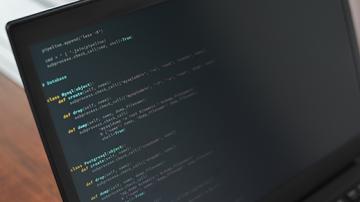The 2.x series of Python is officially over as of January 2020, and unsupported after April 2020, but converting code to Python 3 is easier than you think. Over the weekend, I spent an evening converting the frontend code of a 3D renderer (and its corresponding Python for Qt/PySide version) to Python 3, and it was surprisingly simple in retrospect, although it seemed relatively hopeless during the refactoring process. The conversion process can seem a little like a labyrinth, with every change you make revealing a dozen more changes you need to make.
You may or may not want to do the conversion, but—whether it's because you procrastinated too long or you rely on a module that won't be maintained unless you convert—sometimes you just don't have a choice. And if you're looking for an easy task to start your contribution to open source, converting a Python 2 app to Python 3 is a great way to make an easy but meaningful impression.
Whatever your reason for refactoring Python 2 code into Python 3, it's an important job. Here are three steps to approach the task with clarity.
1. Run 2to3
For the past several years, Python has shipped with a script called 2to3, which does the bulk of the conversion from Python 2 to Python 3 for you. Automatically. And you already have it installed (whether you realize it or not).
Here's a short snippet of code written in Python 2.6:
#!/usr/bin/env python
# -*- coding: utf-8 -*-
mystring = u'abcdé'
print ord(mystring[-1])Run the 2to3 script:
$ 2to3 example.py
RefactoringTool: Refactored example.py
--- example.py (original)
+++ example.py (refactored)
@@ -1,5 +1,5 @@
#!/usr/bin/env python
# -*- coding: utf-8 -*-
-mystring = u'abcdé'
-print ord(mystring[-1])
+mystring = 'abcdé'
+print(ord(mystring[-1]))
RefactoringTool: Files that need to be modified:
RefactoringTool: example.pyBy default, 2to3 prints only the changes required to bring old Python code up to Python 3 standards. The output is a usable patch you can use to change your file, but it's easier to just let Python do that for you, using the --write (or -w) option:
$ 2to3 -w example.py
[...]
RefactoringTool: Files that were modified:
RefactoringTool: example.pyThe 2to3 script doesn't work on just a single file. You can run it on an entire directory of Python files, with or without the --write option, to process all *.py files in the directory and its subdirectories.
2. Use Pylint or Pyflakes
It's not uncommon to discover code quirks that ran without issue in Python 2 but don't work so well in Python 3. Because these quirks can't be fixed by converting syntax, they get past 2to3 unchanged, but they fail once you try to run the code.
To detect such issues, you can use an application like Pylint or a tool like Pyflakes (or the flake8 wrapper). I prefer Pyflakes because, unlike Pylint, it ignores deviations in the style of your code. While the "prettiness" of Python is often praised as one of its strong points, when porting someone else's code from 2 to 3, treating style and function as two separate bugs is a matter of prioritization.
Here's example output from Pyflakes:
$ pyflakes example/maths
example/maths/enum.py:19: undefined name 'cmp'
example/maths/enum.py:105: local variable 'e' is assigned to but never used
example/maths/enum.py:109: undefined name 'basestring'
example/maths/enum.py:208: undefined name 'EnumValueCompareError'
example/maths/enum.py:208: local variable 'e' is assigned to but never usedThis output (compared to 143 lines from Pylint, most of which were complaints about indentation) clearly displays the problems in the code that you should repair.
The most interesting error here is the first one, on line 19. It's a little misleading because you might think that cmp is a variable that was never defined, but cmp is really a function from Python 2 that doesn't exist in Python 3. It's wrapped in a try statement, so the issue could easily go unnoticed until it becomes obvious that the try result is not getting produced.
try:
result = cmp(self.index, other.index)
except:
result = 42
return resultThere are countless examples of functions that no longer exist or that have changed between when an application was maintained as a Python 2 codebase and when you decide to port it. PySide(2) bindings have changed, Python functions have disappeared or been transformed (imp to importlib, for example), and so on. Fix them one by one as you encounter them. Even though it's up to you to reimplement or replace those missing functions, by now, most of these issues are known and well-documented. The real challenge is more about catching the errors than fixing them, so use Pyflakes or a similar tool.
3. Repair broken Python 2 code
The 2to3 script gets your code Python 3 compliant, but it only knows about differences between Python 2 and 3. It generally can't make adjustments to account for changes in libraries that worked one way back in 2010 but have had major revisions since then. You must update that code manually.
For instance, this code apparently worked back in the days of Python 2.6:
class CLOCK_SPEED:
TICKS_PER_SECOND = 16
TICK_RATES = [int(i * TICKS_PER_SECOND)
for i in (0.5, 1, 2, 3, 4, 6, 8, 11, 20)]
class FPS:
STATS_UPDATE_FREQUENCY = CLOCK_SPEED.TICKS_PER_SECONDAutomated tools like 2to3 and Pyflakes don't detect the problem, but Python 3 doesn't see GAME_SPEED.TICKS_PER_SECOND as a valid statement because the function being called was never explicitly declared. Adjusting the code is a simple exercise in object-oriented programming:
class CLOCK_SPEED:
def TICKS_PER_SECOND():
TICKS_PER_SECOND = 16
TICK_RATES = [int(i * TICKS_PER_SECOND)
for i in (0.5, 1, 2, 3, 4, 6, 8, 11, 20)]
return TICKS_PER_SECOND
class FPS:
STATS_UPDATE_FREQUENCY = CLOCK_SPEED.TICKS_PER_SECOND()You may be inclined to make it cleaner still by replacing the TICKS_PER_SECOND function with a constructor (an __init__ function to set default values), but that would change the required call from CLOCK_SPEED.TICKS_PER_SECOND() to just CLOCK_SPEED(), which may or may not have ramifications elsewhere in the codebase. If you know the code well, then you can use your better judgment about how
much alteration is required and how much would just be pleasant, but generally, I prefer to assume every change I make inevitably demands at least three changes to every other file in the project, so I try to work within its existing structure.
Don't stop believing
If you're porting a very large project, it sometimes starts to feel like there's no end in sight. It can seem like forever before you see a useful error message that's not about a Python 2 quirk that slipped past the scripts and linters, and once you get to that point, you'll start to suspect it would be easier to just start from scratch. The bright side is that you (presumably) know that the codebase you're porting works (or worked) in Python 2, and once you make your adjustments, it will work again in Python 3; it's just a matter of conversion.
Once you've done the legwork, you'll have a Python 3 module or application, and regular maintenance (and those style changes to make Pylint happy) can begin anew!










Comments are closed.